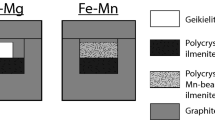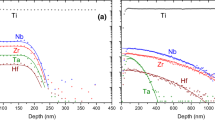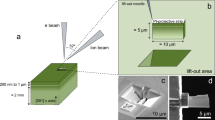Abstract
We have determined Fe–Mg diffusion coefficients in olivines from different sources (Nanga Parbat, Pakistan and San Carlos, Arizona, USA) at atmospheric pressure as a function of composition, oxygen fugacity (10−5–10−12 Pa) and temperature (700–1200°C) using thin films produced by pulsed laser deposition and RBS to analyze the concentration profiles. We have characterized the nano-scale structure and composition of the thin films annealed at various conditions and shown that the nature of the film (e.g. crystallinity, wetting behavior) depends strongly on the annealing conditions. If these variations are not taken into account in the form of boundary conditions for modeling the diffusion profiles, artifacts would result in the diffusion data. The diffusion coefficients obtained from 75 experiments reveal that (i) between fO2 of 10−5 and 10−10 Pa, diffusion along all three principal crystallographic directions in olivine, [100], [010] and [001], are described by a constant activation energy of ∼200 kJ/mol, precluding any temperature dependence of diffusion anisotropy and change of mechanism of diffusion at temperatures between 950 and 1200°C, (ii) diffusion coefficients increase with oxygen fugacity at fO2 > 10−10 Pa, with an fO2 exponent that lies between 1/4 and 1/7, and (iii) at fO2 below 10−10 Pa, and consequently at temperatures below ∼900°C, diffusion becomes weakly dependent/independent of fO2, indicating a change of diffusion mechanism. Activation energy of diffusion at these conditions is slightly higher, ∼220 kJ/mol. The data, including the change of mechanism, are analyzed in terms of point defect chemistry in Part II of this work to derive an equation that allows calculation of diffusivities in olivine over its entire field of stability. Availability of directly measured data at temperatures down to 700°C imply that for the first time diffusion coefficients can be interpolated, rather than extrapolated, for modeling most natural systems.









Similar content being viewed by others
References
Bai Q, Kohlstedt DL (1993) Effects of chemical environment on the solubility and incorporation mechanism for hydrogen in olivine. Phys Chem Miner 19:460–471
Barkmann T, Cemic L (1996) Impedance spectroscopy and defect chemistry of fayalite. Phys Chem Miner 23:186–192
Buening DK, Buseck PR (1973) Fe–Mg lattice diffusion in olivine. J Geophys Res 78:6852–6862
Chakraborty S (1997) Rates and mechanisms of Fe–Mg interdiffusion in olivine at 980°C–1300°C. J Geophys Res 102(B6):12317–12331
Chakraborty S, Costa F (2004) Fast diffusion of Si and O in San Carlos olivine under hydrous conditions. Geochim Cosmochim Acta 68(Suppl. S):A275
Chakraborty S, Ganguly J (1992) Cation diffusion in aluminosilicate garnets: experimental determination in spessartine-almandine diffusion couples, evaluation of effective binary diffusion coefficients, and applications. Contrib Mineral Petrol 111:74–86
Chakraborty S, Farver JR, Yund RA, Rubie DC (1994) Mg tracer diffusion in synthetic forsterite and San Carlos olivine as a function of P, T, and fO2. Phys Chem Miner 21:489–500
Cherniak DJ, Lanford WA, Ryerson FJ (1991) Lead diffusion in apatite and zircon using ion implantation and Rutherford Backscattering techniques. Geochim Cosmochim Acta 55:1663–1673
Chrisey DB, Hubler GK (eds) (1994) Pulsed laser deposition of thin films. Wiley, New York, pp 613
Clark AM, Long JVP (1971) The anisotropic diffusion of nickel in olivine. In: Sherwood JN, Chadwick AV, Muir WM, Swinton FL (eds) Diffusion processes. Gordon and Breach, London, pp 511–521
Coogan L, Hain A, Stahl S, Chakraborty S (2005) Experimental determination of the diffusion coefficient for calcium in olivine between 900°C and 1500°C. Geochim Cosmochim Acta 69:3683–3694
Costa F, Chakraborty S (2004) Decadal time gaps between mafic intrusion and silicic eruption obtained from chemical zoning patterns in olivine. Earth Planet Sci Lett 227:517–530
Costa F, Dungan M (2005) Short time scales of magmatic assimilation from diffusion modeling of multiple elements in olivine. Geology 33:837–840
Crank J (1975) The Mathematics of Diffusion. Oxford University Press, New York, pp 414
Dohmen R, Becker H-W, Meissner E, Etzel T, Chakraborty S (2002) Production of silicate thin films using pulsed laser deposition (PLD) and applications to studies in mineral kinetics. Eur J Mineral 14:1155–1168
Dohmen R, Chakraborty S, Palme H, Rammensee W (2003) The role of element solubility on the kinetics of element partitioning: in situ observations and a thermodynamic kinetic model. J Geophys Res 108(B3):2157. doi:10.1029/2001JB000587
Doolittle LR (1986) A semiautomatic algorithm for Rutherford backscattering spectra. Nucl Instrum Methods B15:227–231
Düffels K, Chakraborty S, Brenker F (2004) Enhacement of diffusion rates in olivine during evaporation—an example of reactive diffusion in a mineralogical system. Lithos 73(Suppl. S):S30
Farver JR, Yund RA, Rubie DC (1994) Magnesium grain boundary diffusion in forsterite aggregates at 1000°C–1300°C and 0.1 MPa to 10 GPa. J Geophys Res 99:19809–19819
Feldman LC (1986) Fundamentals of surface and thin film analysis. North-Holland, New York, pp 352
Ganguly J, Bhattacharya RN, Chakraborty S (1988) Convolution effects in the determination of compositional profiles and diffusion coefficients by microprobe step scan. Am Mineral 73:901–909
Ganguly J, Chakraborty S, Sharp TG, Rumble III D (1996) Constraint on the time scale of biotite-grade metamorphism during Acadian orogeny from a natural garnet–garnet diffusion couple. Am Miner 81:1208–1216
Harrison LG (1961) Influence of dislocations on diffusion kinetics in solids with particular reference to alkali halides. Trans Faraday Soc 57:1191–1199
Hermeling J, Schmalzried H (1984) Tracerdiffusion of the Fe-cations in Olivine (FexMg1−x)2SiO4 (III). Phys Chem Miner 11:161–166
Hier-Majumder S, Anderson IM, Kohlstedt DL (2005) Influence of protons on Fe–Mg interdiffusion in olivine. J Geophys Res 110:B02202. doi: 10.1029/2004JB003292
Ito M, Yurimoto M, Morioka M, Nagasawa H (1999) Co2+ and Ni2+ diffusion in olivine determined by secondary ion mass spectrometry. Phys Chem Miner 26:425–431
Jaoul O, Sautter V, Abel F (1991) Nuclear microanalysis: a powerful tool for measuring low atomic diffusivity with mineralogical applications, in diffusion, atomic ordering, and mass transport. Sel Top Geochem 8:198–220
Jaoul O, Bertran-Alvarez Y, Liebermann RC, Price DP (1995) Fe–Mg interdiffusion in olivine up to 9 GPa at T = 600–900°C; experimental data and comparison with defect calculations. Phys Earth Planet Inter 89:199–218
Jurewicz AJG, Watson EB (1988) Cation in olivine, Part 1: calcium partitioning and calcium–magnesium distribution between olivines and coexisting melts, with petrologic applications. Contrib Mineral Petrol 99:176–185
Kotai E (1994) Computational methods for analysis and simulation of RBS and ERDA spectra. Nucl Instr Meth B 85:588–596
Lovering TS (1936) Heat conduction in dissimilar rocks and the use of thermal models. Bull Geol Soc Am 47:87–100
Meissner E, Sharp TG, Chakraborty S (1998) Quantitative measurement of short compositional profiles using analytical transmission electron microscopy. Am Miner 83:546–552
Misener DJ (1974) Cation diffusion in olivine to 1400°C and 35 kbar. In: Hofmann AW, Giletti BJ, Yoder HS Jr, Yund RA (eds) Geochemical transport and kinetics. Carnegie Inst. Wash. Publ., vol 634. Washington Carnegie Inst., pp 117–129
Morioka M (1981) Cation diffusion in olivine—II. Ni–Mg, Mn–Mg, Mg and Ca. Geochim Cosmochim Acta 45:1573–1580
Morioka M, Nagasawa H (1991) Ionic diffusion in olivine. In: Ganguly J (ed) Diffusion, atomic ordering and mass transport. Adv Phys Geochem 8:176–197. Springer, Heidelberg
Nakamura A, Schmalzried H (1983) On the nonstoichiometry and point defects of olivine. Phys Chem Miner 10:27–37
Nakamura A, Schmalzried H (1984) On the Fe2+-Mg2+-interdiffusion in olivine (II). Ber Bunsenges Phys Chem 88:140–145
Petry C, Chakraborty S, Palme H (2004) Experimental determination of Ni diffusion coefficients in olivine and their dependence on temperature, composition, oxygen fugacity, and crystallographic orientation. Geochimica Cosmochimica Acta 68:4179–4188
Rumble III D, Finnerty TA (1974) Devonian Grossularite-Spessartine overgrowths on Ordovician Almandine from Eastern Vermont. Am Miner 59:558–562
Schmalzried H (1981) Solid state reactions. Verlag Chemie, Weinheim
Stocker RL, Smyth DM (1978) Effect of enstatite activity and oxygen partial pressure on the point defect chemistry of olivine. Phys Earth Planet Inter 16:145–156
Tirone M, Ganguly J, Dohmen R, Langenhorst F, Hervig R, Becker H-W (2005) Rare earth diffusion kinetics in garnet: experimental studies and applications. Geochim Cosmochim Acta 69:2385–2398
Tsai T-L, Dieckmann R (2002) Variation of the oxygen content and point defects in olivines, (FexMg1−x)2SiO4, 0.2 ≤ x ≤ 1.0. Phys Chem Miner 29:680–694
Acknowledgments
Undergraduate students Julia Halfmann and Daniela Lüttgebüter have provided substantial help in the high temperature furnace laboratory as well as in the thin film deposition laboratory at different stages of this work. In addition, Julia Halfmann helped with white light interference microscopy. Their enthusiasm was contagious. The help of Dr. Rolf Neuser at the SEM and Dr. Hans-Jürgen Bernhardt at the microprobe laboratory were indispensable. Dr. W. Gebert oriented some of the olivine crystals for us. None of the experiments would be possible without the efforts of Tanya Westphal at the polishing lab. The German Science Foundation (DFG) generously sustained this project through material support and by covering the entire salary of the first author. This support was obtained in part within the interdisciplinary program SFB 526 (Rheology of the Earth). We gratefully acknowledge the help from all of these individuals and organizations. Finally, we thank Daniele Cherniak and Bill Carlson for their constructive reviews which helped to revise the manuscript.
Author information
Authors and Affiliations
Corresponding author
Rights and permissions
About this article
Cite this article
Dohmen, R., Becker, HW. & Chakraborty, S. Fe–Mg diffusion in olivine I: experimental determination between 700 and 1,200°C as a function of composition, crystal orientation and oxygen fugacity. Phys Chem Minerals 34, 389–407 (2007). https://doi.org/10.1007/s00269-007-0157-7
Received:
Accepted:
Published:
Issue Date:
DOI: https://doi.org/10.1007/s00269-007-0157-7




